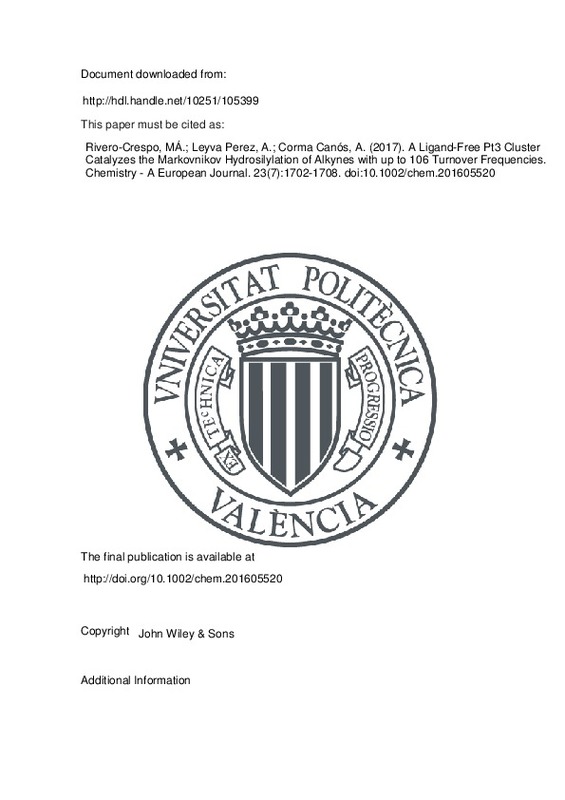JavaScript is disabled for your browser. Some features of this site may not work without it.
Buscar en RiuNet
Listar
Mi cuenta
Estadísticas
Ayuda RiuNet
Admin. UPV
A Ligand-Free Pt3 Cluster Catalyzes the Markovnikov Hydrosilylation of Alkynes with up to 106 Turnover Frequencies
Mostrar el registro sencillo del ítem
Ficheros en el ítem
| dc.contributor.author | Rivero-Crespo, Miguel Ángel
|
es_ES |
| dc.contributor.author | Leyva Perez, Antonio
|
es_ES |
| dc.contributor.author | Corma Canós, Avelino
|
es_ES |
| dc.date.accessioned | 2018-07-06T07:17:05Z | |
| dc.date.available | 2018-07-06T07:17:05Z | |
| dc.date.issued | 2017 | es_ES |
| dc.identifier.issn | 0947-6539 | es_ES |
| dc.identifier.uri | http://hdl.handle.net/10251/105399 | |
| dc.description.abstract | [EN] The Pt-catalyzed hydrosilylation of alkynes is the procedure of choice to obtain vinylsilanes, and is claimed to be the most relevant application of Pt in organic synthesis. More than half a century after its discovery, only b-vinylsilanes (anti-Markovnikov addition) are obtained with simple Pt catalysts, whereas a-vinylsilanes (Markovnikov addition)remain elusive compounds.Here the catalysis of the Markovnikov hydrosilylation of terminal alkynes by Pt3clusters, in parts-per-million amounts, to give a wide variety of a-vinylsi-lanes in reasonable isolated yields and with turnover fre-quencies that can reach up to one million per hour is reported. Moreover, these a-vinylsilanes are reactive in well-stablished C@Cbond-forming cascade reactions, in which thecorresponding b-isomers are unreactive. Besides its efficiency and synthetic usefulness, this catalytic system is an excellent example of how the atom-by-atomaggregation of a catalytic metal leads to a different selectivity for a given reaction | es_ES |
| dc.description.sponsorship | Financial support by MINECO (RETOS program, CTQ201455178-R) and "Severo Ochoa" program is acknowledged. M. A. R.-C. thanks for a FPU scholarship. | en_EN |
| dc.language | Inglés | es_ES |
| dc.publisher | John Wiley & Sons | es_ES |
| dc.relation.ispartof | Chemistry - A European Journal | es_ES |
| dc.rights | Reserva de todos los derechos | es_ES |
| dc.subject | Alkynes | es_ES |
| dc.subject | Cluster compounds | es_ES |
| dc.subject | Hydrosilylation | es_ES |
| dc.subject | Platinum | es_ES |
| dc.subject | Silanes | es_ES |
| dc.subject.classification | EDAFOLOGIA Y QUIMICA AGRICOLA | es_ES |
| dc.subject.classification | QUIMICA ORGANICA | es_ES |
| dc.subject.classification | QUIMICA ANALITICA | es_ES |
| dc.title | A Ligand-Free Pt3 Cluster Catalyzes the Markovnikov Hydrosilylation of Alkynes with up to 106 Turnover Frequencies | es_ES |
| dc.type | Artículo | es_ES |
| dc.identifier.doi | 10.1002/chem.201605520 | es_ES |
| dc.relation.projectID | info:eu-repo/grantAgreement/MINECO//CTQ2014-55178-R/ES/HIERRO Y BISMUTO SUB-NANOMETRICO Y CATALITICO/ | es_ES |
| dc.rights.accessRights | Abierto | es_ES |
| dc.contributor.affiliation | Universitat Politècnica de València. Instituto Universitario Mixto de Tecnología Química - Institut Universitari Mixt de Tecnologia Química | es_ES |
| dc.contributor.affiliation | Universitat Politècnica de València. Departamento de Química - Departament de Química | es_ES |
| dc.description.bibliographicCitation | Rivero-Crespo, MÁ.; Leyva Perez, A.; Corma Canós, A. (2017). A Ligand-Free Pt3 Cluster Catalyzes the Markovnikov Hydrosilylation of Alkynes with up to 106 Turnover Frequencies. Chemistry - A European Journal. 23(7):1702-1708. https://doi.org/10.1002/chem.201605520 | es_ES |
| dc.description.accrualMethod | S | es_ES |
| dc.relation.publisherversion | http://doi.org/10.1002/chem.201605520 | es_ES |
| dc.description.upvformatpinicio | 1702 | es_ES |
| dc.description.upvformatpfin | 1708 | es_ES |
| dc.type.version | info:eu-repo/semantics/publishedVersion | es_ES |
| dc.description.volume | 23 | es_ES |
| dc.description.issue | 7 | es_ES |
| dc.relation.pasarela | S\337304 | es_ES |
| dc.contributor.funder | Ministerio de Economía y Competitividad | es_ES |







![[Cerrado]](/themes/UPV/images/candado.png)

